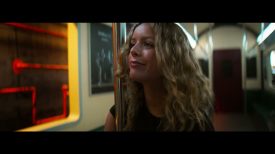By Jonah Kessel
Word Crimes from Jonah Kessel on Vimeo.
Murong Xuecun is one of the least boring people I have ever met.
He is energetic. He is dynamic. He is impressively clever. And in the last year, he has emerged as one of the most outspoken critics of censorship in China.
However, he is a writer.
And when New York Times’ correspondent Edward Wong first mentioned he was writing an in depth feature on Murong, I initially doubted an accompanying video component would help add much value to the package. I did some background research and found articles with still pictures of the young writer. Nearly every single one showed the author looking at a computer in some form or another, 3 out of 4 being a silhouetted picture of the back of his head with the computer out of focus or him at an internet café.
The images I saw were far from inspiring. I imagined a video full of talking heads, with sequences of static imagery that would inevitably go on for too long and insight viewers to click away.
But right before I decided it wasn’t worth making the video, I read this speech Murong had recently given which discussed censorship of written work in China. Words started jumping off the page:
This is castrated writing. I am a proactive eunuch, I castrate myself even before the surgeon raises his scalpel. Our language has been cut into two parts: one safe, and the other risky. Some words are revolutionary, and others are reactionary; some words we may use, and others belong to our enemies.
And just like that, I was hooked. This person was clearly an outspoken agent calling for change and reform in Chinese society. All of a sudden Murong turned from a writer into an incendiary subject on a hot topic. I jumped on board and got to thinking — how do I make a person who is visually boring interesting? And my first inspiration came directly from the same speech. Toward the top of his speech Murong discusses words likely to be censored should he use them in his books:
From my many years’ experience in writing and publishing, I could compile a Sensitive Words Glossary, in which you would certainly find the words “system,” “law,” “government,” as well as a large number of other nouns, several verbs, quite a few adjectives, and even a few special numbers. The glossary would also include all names of religions, all names of important people, all countries, including of course China, and also the phrase “Chinese people.”
On the backend of the speech, the author continued:
If there really were a Sensitive Words Glossary, I hope that it could be published; in this way at least we could all save a lot of time, and reduce the possibility of unwittingly committing “word crimes.”
My idea for the video came to me while sitting in a small airport in Burlington, Vermont on my way back to China I thought — maybe I can help him publish this list of sensitive words. I dreamed up a bunch of scenarios of how I could visualize a list of words and eventually came to the conclusion that I should let this man say the words that ordinarily he can’t say.
This train of thought continued onto the topic of voiceovers vs subtitles. Most international broadcast news videos gets a voiceover treatment – I started thinking it would be completely ironic to mute the man, when he is in fact, talking about words which he cannot use. I decided subtitles were more appropriate – which then opened up more doors for cinematic storytelling and made it a little easier to justify adding music to a news piece. Although I was excited to make the piece I was still a bit worried about keeping it moving and wanted the music to help keep the piece from drying up.
Now, regardless of the man’s profession, I had a hot subject and an idea for a snappy intro. I had music to help move the piece in a rhythmic narrative and a logic behind how I would represent his opinions visually.
And while I knew I had to film him writing or at the computer, I also knew I wanted to get him out of the context where we are used to seeing writers. When you get stuck shooting a “boring” person (or one who doesn’t do anything visually exciting) I think its a great exercise to find a new physical environment. Simply get them out of the physical environment where we expect to see them. It doesn’t matter where — just someplace else. I wanted to see him interacting with people and when I found out he was going out to dinner with some journalists and human rights lawyers, I was ecstatic when I got the invite to tag along.
This was the trickiest part of the video — both visually and narratively. How to link the home interviews, the writing visuals and a bunch of guys at dinner. With some thinking, it was easy enough to have narration lead the story into the restaurant, but shooting this was much more tricky.
There’s a Zoom H1 hidden on the table near the bear drinking, cigarette smoking intellectuals. I have a Canon 60D switching between a Gorilla Pod, a tripod and the in-table lazy susan. In addition, I had a 5D mkII on a shoulder rig. And while I didn’t leave a camera rolling the entire time, I did leave the audio rolling. When I got back, I synched all of the audio with the video clips I had. Although I had tons of great dialogue in the end I just grabbed one meaty quote that allowed me to jump from frame to frame anachronistically. Had I used multiple quotes or too much back and forth dialogue, I would have been forced into using more real time footage. Using just one quote allowed me to use some of my favorite visuals from the entire night.
With the intro set and multiple environments in the bank, I just needed to shoot the interviews. Knowing that I was at risk of having a boring video, I kept two cameras rolling continually during the interviews so when it came time to cut, I could keep all my frames short and bounce between a Canon 50mm f1.2 and a Canon 24mm f1.4.
With the credit roll, intro and title sequence, the video came out at 4 minutes and 20 seconds. Keeping voiceover out, adding music, using multiple environments and multiple cameras rolling during interviews, I hope I succeeded in making a visually “boring person” interesting.
And while I can’t answer that question for you, I can say the greater lesson I took away from this project are the potential assets we gain from simply researching what our subjects. What they have to say, have said and what they might want to say.
MORE ON MURONG XUECUN:
• Read Edward Wong’s story “Pushing China’s Limits on Web, if Not on Paper”
• An Excerpt from ‘Leave Me Alone: A Novel of Chengdu’
• More on Murong: Words We Can Use, and Those We Can Not
— Jonah M. Kessel is a Beijing based freelance visual journalist working with the New York Times. See his web site here and follow him on Twitter here.






